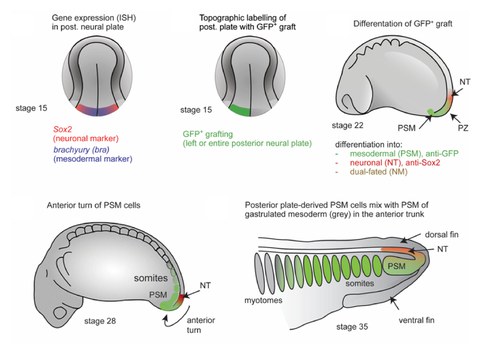May 04, 2023
NEUER ARTIKEL: Mechanismus der Rumpf- und Schwanzmuskelbildung und Achsenverlängerung im Axolotl
Find the article here.
Abstract
Elongation of the posterior body axis is distinct from that of the anterior trunk and head. Early drivers of posterior elongation are the neural plate/tube and notochord, later followed by the presomitic mesoderm (PSM), together with the neural tube and notochord. In axolotl, posterior neural plate-derived PSM is pushed posteriorly by convergence and extension of the neural plate. The PSM does not go through the blastopore but turns anteriorly to join the gastrulated paraxial mesoderm. To gain a deeper understanding of the process of axial elongation, a detailed characterization of PSM morphogenesis, which precedes somite formation, and of other tissues (such as the epidermis, lateral plate mesoderm and endoderm) is needed. We investigated these issues with specific tissue labelling techniques (DiI injections and GFP+ tissue grafting) in combination with optical tissue clearing and 3D reconstructions. We defined a spatiotemporal order of PSM morphogenesis that is characterized by changes in collective cell behaviour. The PSM forms a cohesive tissue strand and largely retains this cohesiveness even after epidermis removal. We show that during embryogenesis, the PSM, as well as the lateral plate and endoderm move anteriorly, while the net movement of the axis is posterior.

